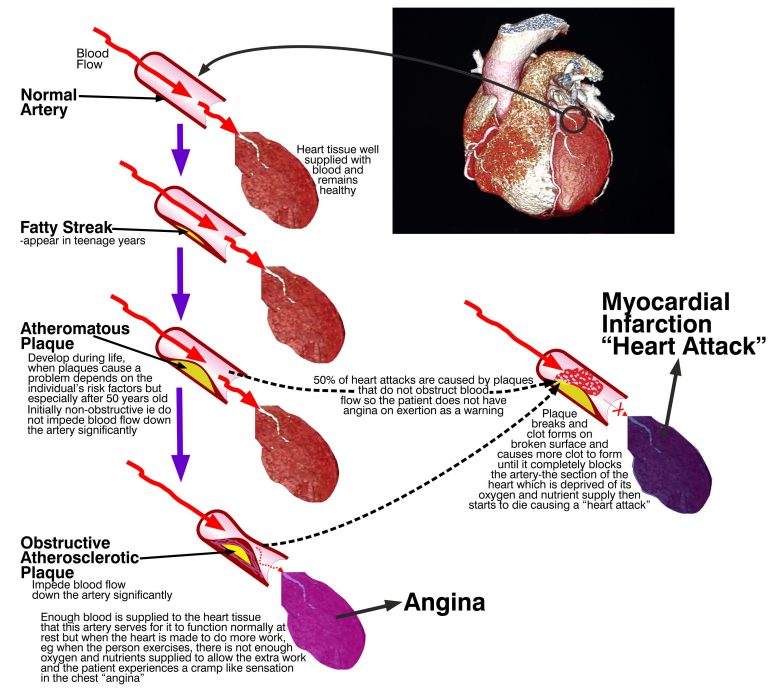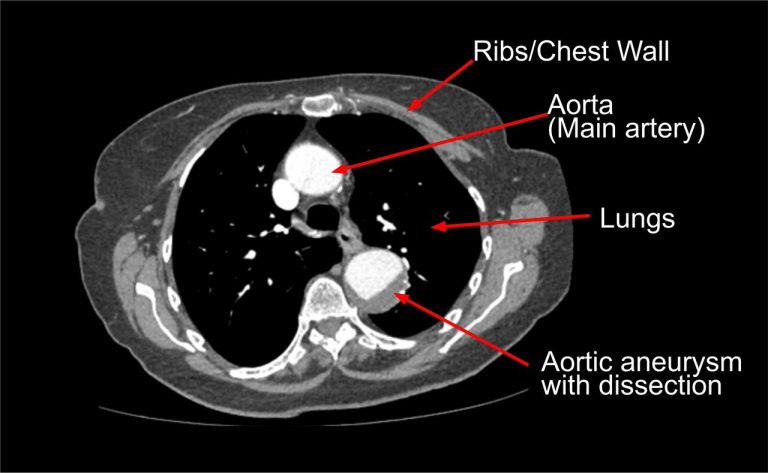Coronary Artery Disease
As we age like all of the other tissues in our bodies our arteries gradually deteriorate. In the teenage years fat first appears in the wall of our arteries. By the time we are 50 years old some deterioration in the coronary arteries can be detected in virtually 100% of people using intravascular ultrasound. This process can occur earlier and be more pronounced with
- A family history of heart or other vascular disease (probably because of inherited genes)
- High Blood Pressure
- High blood lipids (cholesterol)
- Smoking
However in most people the narrowing is very minor and blood flow down the artery is not impeded.
Angina
In some people the narrowing of the arteries is enough to limit blood flow down the artery so that when the individual exercises and causes the heart to work harder the part of the heart that is supplied by the artery is not getting enough of a blood supply. The sensation from this part of the heart is usually felt as tightness in the chest angina. If the patient rests usually enough blood can get down the narrow artery to supply the needs of the heart muscle when the heart is resting and so the angina wears off.
If angina is increasing in frequency or in the ease with which it can be brought on and especially if it occurs at rest then the patient should be admitted to hospital.
There are aspects that are surprising – the severity of the discomfort from angina does not equal the severity of the underlying coronary artery disease. Not everyone feels angina in the centre of the front of the chest-it can be felt in the back, in the jaw, as an ache in the top of the arm. Angina may occur one day doing a particular type of exertion but then on another day doing the same exertion it does not occur. This is because the arteries are not rigid tubes like drainpipes but are living tubes with a sheet of muscle in the wall so the diameter can vary-if the muscle in the wall is less relaxed the diameter of the artery will be smaller and angina will occur more easily on that day.

Heart Attack
The heart beats approximately 100,000 times per day. Each beat increases the blood pressure so there are 100,000 pressure waves going down the coronary arteries each day-36 million per year. One of these pressure waves can one day cause a break in one of the atheromatous plaques fat deposits in the body. This break in the lining of the wall of the artery to the blood rushing by looks like a defect that needs repair-similar to a cut. The blood starts to form a clot and if this clot blocks the artery no blood can pass down the artery. Then the part of the heart supplied by the artery dies as it is not getting a blood supply. This is a heart attack or a myocardial infraction.
The dying heart cells release an enzyme called troponin into the blood which can be detected with a blood test. It is this test that is done in hospital if someone has chest pain-to see if they have had a heart attack. The discomfort from a heart attack is similar to angina but it persists and does not go away until part of the heart dies-this takes a few hours. Approximately 50% of heart attacks occur in areas of the artery where the narrowing is not enough to cause angina. So heart tests for coronary artery disease that only look for limitation of flow down the arteries will miss these plaques.
Pericarditis
Inflammation of the lining of the heart-gives a different type and duration of chest discomfort.
Other Causes
There are many other structures in the chest that can cause chest pain such as the lungs and great vessels. In addition the chest discomfort can come from the muscles, bones and cartilage in the chest wall.

This 85 year-old lady had an aortic dissection split in the aorta. She had been treated at her local teaching hospital for a chest infection but actually had a liver abscess. The split in the aorta, aortic aneurysm coronary artery disease had not been picked up.
